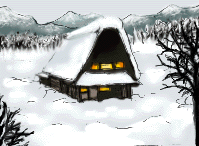Dear friends,
It is getting colder and colder, isn't it?
I hope you don't have a cold.
 These days there have been winds blowing from the north-west and it snows hard in Hokkaido and the area on the side of the Sea of Japan, TV says.
These days there have been winds blowing from the north-west and it snows hard in Hokkaido and the area on the side of the Sea of Japan, TV says.
In Shikoku it seldom snows except the villages among mountains and is relatively warm.
Christmas and New Year is drawing near. Some of you may be busy at the end of the year because of the Y2K problem.
This month I'll read about "joya no kane" from "Japan - an illustrated Encyclopedia"(Kodansha).
"joya no kane(New Year's Eve bells)
. Beginning on New Year's Eve and continuing into New Year's Day, the bells in Buddhist temples in Japan are rung each year to announce the passing of the old year and coming of the new. Because of the Buddhist belief that human being are plagued by 108 earthly desires or passions(bonno), the bells are rung a total of 108 times; with each toll of the bell, one desire is dispelled."
I won't do anything particular at Christmas except reading "Holy Bible" alone this year because I'm not a Christian, but I love the story about the Birth of Jesus Christ.
At the end of the year I am to celebrate New Year of A.D.2000 hearing "joya no kane" from the near-by Buddhist temple and to go to see the sunrise on New Year's Day.
Then,
I wish you all A Merry ChristmasandA Happy New Year!! |